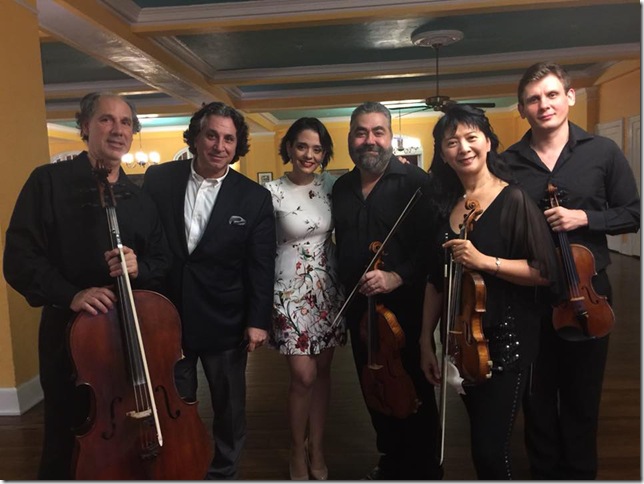By Robert Croan
The Delray String Quartet featured three works, each containing some sort of spiritual connection, in its Jan. 15 concert at Fort Lauderdale’s All Saints Episcopal Church. The sacred elements, however — variously Catholic, Jewish and Russian Orthodox — were secondary to the music itself, window dressing perhaps, to conform to the evening’s venue.
Central to the event was the String Quartet No. 7 by Richard Danielpour, an American Jewish composer of Persian descent, which the composer has subtitled Psalms of Solace. The work was commissioned by the Delray players, who gave the world premiere in May 2015 at Coral Gables’ Mainly Mozart festival.
In the world of contemporary music, it is often more difficult to get a second, third, or fourth performance of a new work than a premiere, and the ensemble is addressing that issue by including Danielpour’s latest quartet in its current touring programs. It’s not a groundbreaking composition, but it’s eminently listenable, solidly constructed, and in all, a welcome addition to the string quartet repertory.
The Delray String Quartet was created in 2003 by former Broadway producer and businessman Don Thompson with players culled from the Florida Philharmonic, which had disbanded that year for financial reasons. With relatively humble beginnings, and some changes in personnel, the chamber group has thrived, and is now recognized as a major string quartet on today’s concert scene.
Part of its mission is the performance of new American works. The Delray has already played Danielpour’s two previous string quartets – Nos. 5 and 6 –and has recorded these works, along with Psalms of Solace, for release on the Naxos of America label this year. Current members of the quartet are violinists Mei Mei Luo and Valentin Mansurov, violist Richard Fleischman and cellist Claudio Jaffé. Throughout the evening, their playing was marked by technical security, impeccable intonation and togetherness of intent.
Danielpour, who turns 60 this month, is an established composer with a large body of works that are regularly performed by American orchestras and smaller musical ensembles. His music is just modern enough to bear the composer’s individual stamp, mildly dissonant while remaining pleasantly melodic as well, idiomatically written for the performers and serious in intent. These qualities pervade his Seventh String Quartet, which begins with sustained slow chords, “mysterious and songful,” according to the score, that support high, descending melodic patterns.
At the start, violist Fleischman explained that each movement represented the search for a higher power in a different way. The second movement counters the opening peaceful inquiry with a fierce kinetic scherzo, expressing anger, rage and perhaps frustration. The Adagietto that follows is marked “simply moving.” It’s the most sentimental section of the work, pleasant and bordering on the trite. The Delray players imbued this music with particular emotion and affection.
Most effective is the Quartet’s final movement, in which Danielpour introduces a soprano vocalist — on this occasion Cuban soprano Maria Aleida, who sings lines in Hebrew derived from from Psalms Nos. 40 and 96; and in English derived from Isaiah and the Gospel of St. Luke. Aleida, an accomplished high coloratura with a bright penetrating sound, complemented the string sonorities with equally accurate intonation and musical security. Her vocalism was quite beautiful, though verbal values were sometimes lost, and one had to strain to ascertain at which point she switched from Hebrew to English.
Danielpour’s quartet was framed by Mozart’s Exsultate, jubilate (K. 165), labeled a motet but actually a three-movement concerto in operatic style, with the soprano voice as the solo instrument. Mozart wrote it in 1773 for a famous virtuoso castrato. The castrati at that time were known for their enormous power and breath control, and the fast movements of Exsultate contain roulades of great length, most of which soloist Aleida took on a single breath without flinching.
Her voice is not large, but it easily cut through the instrumental texture and filled the spaces of the church. She gave a sensational cadenza at the end of the opening movement, reaching a high F that would have done credit to any Queen of the Night in Mozart’s The Magic Flute. The famous concluding Alleluia was pure joy. But it was not all showmanship: the singer was equally adept in expressing the softer emotions of the middle movement, a melting Andante dedicated to the “crowned virgin.”
After intermission, the quartet turned to the Quartet No. 2 by Anton Arensky (in A minor, Op. 35a), a younger contemporary of Tchaikovsky, who wrote this piece as an homage to his teacher and idol. The music is derivative and lackluster, its central movement a set of variations on a theme by Tchaikovsky, in which each of the instruments has ingratiating opportunities to shine. Originally written for the unusual combination of violin, viola and two cellos, the present version is Arensky’s own arrangement for standard string quartet, retaining, however, the emphasis on low, brooding sonorities.
The most engaging passage comes at the end, when Arensky writes a sprightly fugue on a Russian folk tune familiar to music lovers from its appearances in Beethoven’s second Razumovsky quartet and the coronation scene in Mussorgsky’s Boris Godunov.
